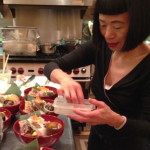Today sashimi, ceviche and crudo has become very popular and hip menu items at restaurants throughout the country. Two days ago at Family and Friends Dinner at the new Tavern on the Green (https://ny.eater.com/tags/tavern-on-the-green) we did not fail to find a ceviche dish (creation by chef Kath Spark), so we ordered it. A new Ceviche restaurant (https://www.yelp.com/biz/cevich-new-york) just opened on our 15th street across the old Tiffany building, which is now converted to a modern apartment building. I have not tried this new place yet, but Yelp review has already gave the store 5 stars.
To me the best way to enjoy sashimi, ceviche or crudo type of dishes is to make my own dish in my kitchen, unless I am eating out at 15 East, Sushi Seki or other noted sushi restaurants in the city. In this way I can control the quality of the fish to use in the preparation and hygiene standard in my kitchen. After moving to America making sashimi dish or challenging ceviche in my home kitchen became rare activity. For my professional business I have an access to high quality sushi fish through a reliable sushi fish distributor, which caters to top sushi and American restaurants in New York City. As a consumer, purchasing good quality fish for raw consumption at local fishmongers is not possible or difficult. If it is possible the choice always falls on tuna, salmon and hamachi. That’s it. No pleasure of making sashimi, ceviche or crudo with this limited selection of fish.
eating out at 15 East, Sushi Seki or other noted sushi restaurants in the city. In this way I can control the quality of the fish to use in the preparation and hygiene standard in my kitchen. After moving to America making sashimi dish or challenging ceviche in my home kitchen became rare activity. For my professional business I have an access to high quality sushi fish through a reliable sushi fish distributor, which caters to top sushi and American restaurants in New York City. As a consumer, purchasing good quality fish for raw consumption at local fishmongers is not possible or difficult. If it is possible the choice always falls on tuna, salmon and hamachi. That’s it. No pleasure of making sashimi, ceviche or crudo with this limited selection of fish.
So, here is my piece of advice on how to get quality fish for our sashimi, ceviche or crudo making in our kitchen.
- Go to Japanese food store where they carry fish for sushi & sashimi preparation. (https://www.mitsuwa.com/) Fish for raw consumption are usually packed in Styrofoam trays with plastic lids or wrap and an expiration or sell-by date. The packages of sushi fish are stored in a refrigerator case separate from fish meant for cooking.
- Some American fishmongers sell sushi-grade tuna. I don’t buy this type of sushi-grade tuna for raw consumption. It is usually not individually, professionally wrapped, and is displayed on the shared ice bed with other filleted fish.
- Some American food stores carry frozen sushi tuna, hamachi and salmon. Make sure that it is frozen hard and there is no trace of being defrosted.
- Do not purchase already filled fish at American fishmongers for sushi & sashimi, ceviche or crudo preparation. They are for cooking.
- Check out your local Greenmarket fishmonger. In my case it is Blue Moon https://www.bluemoonfish com/press/.
 Blue Moon brings very fresh, sushi quality fish to the market. Confirm the freshness of the fish – whole fish – using the below check list. Purchase the whole fish and scale, guts and fillet it at home for your sushi, ceviche and crudo.
Blue Moon brings very fresh, sushi quality fish to the market. Confirm the freshness of the fish – whole fish – using the below check list. Purchase the whole fish and scale, guts and fillet it at home for your sushi, ceviche and crudo. - Additional tips on buying Greenmarket whole fish. Go to the store earliest in the morning while it is cold/cool, even during hot summer months. Bring an ice box with you to the market and carry the fish back with ice cubes, which is supplied by the fish monger. Scale, gut, clean and fillet the fish immediately in hygine controlled kitchen. Store the fish, covered, in the refrigerator until use. Better to eat the fish on the day of the purchase.
Freshness check list:
- Eyes should be clean, clear and round

- Fish looks like just it came out of the water
- Gill is bright red
- The body is plump
- Gently press the body of the fish with your index finger; the flesh springs up and leaves no depression
Next week I will try ceviche with Blue Moon’s freshest fish.
